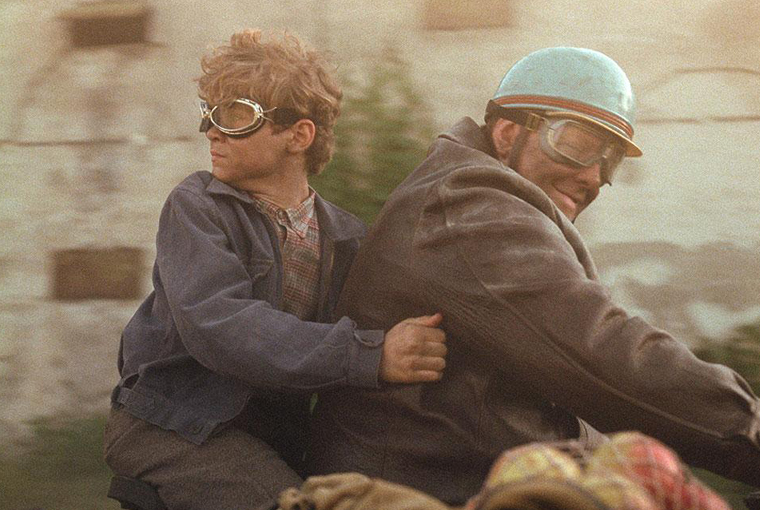
From formal framing and fluid cinematography to historically accurate set design, Orphan is a somber depiction of war-torn Budapest following the failed 1956 uprising. The film’s narrative centers on young Andor and his mother Klára. When Berend, a stranger from the countryside, begins courting Klára, Andor begins to question his father’s true identity. After it is revealed that Berend is Andor’s biological father, the boy rejects the idea and seeks justice for the man he insists is his parent, a Jew gone missing during WWII.
Bearlike in stature, butcher Berend (played flawlessly by Grégory Gadebois) cuts a formidable figure amongst the townspeople. Brutish and unpredictable, his villainous behavior occasionally slips into that of a spoiled child. His well-meaning acts of generosity are misguided or backfire, such as gifting a pig carcass to the family, which Andor (Bojtorján Barabas) refuses to eat and instead vandalizes due to his fictitious dead father’s Jewish roots. Coming as a surprise to Andor and Klára (Andrea Waskovics), Berend encourages them all to dress up and visit a sold-out show at the theater. Once denied entry for lack of spare seats, Berend throws a violent tantrum and instigates a bar fight before he is escorted outside. He is a Soviet sympathizer and uses his comrade connections to profit from the city’s occupation. Yet Berend also has the capacity to love and shows fatherly vulnerability towards Andor despite the boy’s unfounded hatred and rejection. He admits to Andor that their partnership is a bit of an unwanted surprise to himself: “I was looking for your mum and I found you too.” Even before he is certain he is in fact Andor’s father, Berend treats Andor to motorcycle rides and boxing matches. However, his efforts are inadequate, so as Berend’s interest in their relationship grows, so does Andor’s hostility towards him.
László Nemes is well-known for his technical prowess and Orphan is a continuation of the director’s signature artistry. The sepia tone of this period piece, coupled with the pin-hole camera style, makes the film’s aesthetic resemble an antique photograph from WWII. Every exterior location is littered with dust and rubble from bombings. Dirt, brick, and ash stain the clothes of the sickly citizens. Although the film contains plenty of iconic tropes of the traditional war film genre, the story only uses it as a backdrop for Andor’s loss of innocence. For example, when Andor steals a pistol from a Hungarian deserter hiding from the law, he accidentally alerts nearby soldiers to his hiding place and the young man is shot to death off-screen. This seemingly important narrative development is somewhat inconsequential for Andor, who continues his mission unaffected. His tragic escapade is never addressed by the supporting cast either.
The film’s final sequence concludes not with a bang, but with a whimper. Berend’s crooked local contacts allow the family into the town’s fair free of charge and before the opening night. Andor, armed with a stolen pistol, lures Berend onto the Ferris wheel without his mother. The dramatic irony of their dynamic and the setting of the scene build a heightened sense of anticipation and tension. Shot from a low angle, the grand, golden structure looms over the attendants. The rattle of the cage door and the creak of the rotating mechanism act as an audible manifestation of Andor’s ever-increasing emotional strain. The seclusion of their environment, swaying unsteadily high above ground level, raises the degree of danger for the already volatile two characters stuck inside the booth. The unsuspecting Berend admires the view, a smirk of excitement on his face. His assumption is that Andor is finally coming to terms with him as his real father. He leans in and unveils his plan to marry Andor’s mother. A look of anger and sadness falls across Andor as he begins to shake with hatred. His biggest fear realized, the agony of his body language spreads to his eyes, filled to the brim with such dislike that they vibrate. Andor pulls the pistol from its concealment and aims it directly at Berend’s head. Berend’s smirk vanishes and his shoulders stiffen. He appears both disheartened and frustrated that the ride was not the opportunity of father-son intimacy he thought it was. As Andor hesitates, his conviction dwindles. Berend’s mood swings quickly to rage and he snaps the gun from the child’s hands, demanding Andor to keep this incident a secret from his mother. At ground level, the oblivious Klára joins Andor and Berend on the Ferris wheel and the ride continues its leisurely journey once again.
This understated finale is a clever execution where the disappointment of the spectator mirrors Andor’s unfulfilled act of vengeance. The promise and lack of violence or emotional outburst lend the scene an awkward realism where both the audience and characters are left with not only a sour taste in their mouths but a burning sense of embarrassment. More importantly, the symbolism of the wheel is suggestive of the cyclical nature of familial trauma and the expectation that Andor must relive it again and again either as the victim or as the assailant.

Leave a Comment